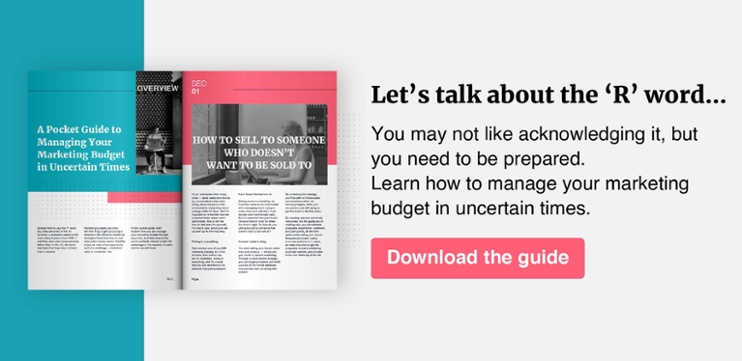2020 has laid bare the critical importance of digital-first marketing strategies. But when it comes to content, many businesses make critical mistakes time and again. In this post, we’ll take a look at six mistakes that could undermine your content marketing strategy and what you should do to fix them.
You aren’t writing for specific reasons
It’s no secret that more and more businesses are investing in content marketing. But that doesn’t mean you should create content simply because others are doing it. If you are publishing without a clear goal in mind, your content likely won’t deliver outcomes. You need to tailor your content marketing efforts to specific goals like:
- Increasing website traffic
- Generating leads
- Nurturing leads and subscribers
- Generating sales
- Building customer loyalty
- Etc.
Suggested reading: check out our free template – Best Practice Template: Determine Your SMART Marketing Goals
What you should do instead:
Define the outcomes you want your content to elicit with your audience. Every type of content speaks to an audience with a different level of intent. So you need to be clear about the reason you’re writing each piece of content.
Some content pieces are meant to raise awareness, others encourage consideration, and then some push towards making a buying decision. Then decide how the reader is likely to find your content. For example, via:
- Organic traffic
- Social media traffic
- Email nurture
- Ad campaigns
Taking these two factors into consideration will impact what you write. For example, an organic blog post should be written for a more general audience — allowing it to appeal to a wide range of readers and rank for general search terms. Conversely, a piece written for an email marketing campaign should speak more directly to a specific target audience, and potentially address your product in more direct detail. You can then build an editorial calendar that weaves together different pieces of content with different goals in complementary ways.

You don’t understand your target audience
If you don’t understand your audience, you are likely to write about the wrong things, or write in ways that don’t resonate. Targeting the wrong topics might result in views and web traffic. But only by drawing in the right people (and talking to them in the right way) will you be able to transform those “eyeballs” into customers. If your content doesn’t resonate with your target audience, it won’t get you closer to your marketing goals. It must be aligned with their concerns and language.

What you should do instead:
Get to know your existing customers. Ask about their needs and wants. Have them fill out surveys to tell you what their unmet needs are, what they want more of, and how you can help. Find out the topics they care about, the goals they hope to achieve, and the pain points that keep them up at night. Once you do that, great content ideas will start popping up in your mind.
Create buyer personas and write content that’s relevant to them. Start by collecting information about clients from your sales and support teams. Once you have detailed personas, create content that’s specific to each one. That content should empathise with them and use a language and voice that speaks to them.
You’re focusing on volume over quality
If you’re posting new content regularly, good — keep doing it. Consistency does help a lot with SEO and domain authority. But a badly written or incomplete blog post doesn’t have a great chance of ranking. And it’s quality content that turns leads from cold to warm. Poorly constructed content can even be counterproductive — driving away prospects and making you look incompetent. On top of that, blasting your audience with new content too frequently runs the risk of burning them out, which means less engagement with your site and email lists.
What you should do instead:
Take the time to craft awesome content. Publishing a new piece every week is a good target to aim for. But if you need more time to create content that’s well-researched, informative, unique, and visually compelling, change your content calendar to publishing once every other week. Find the frequency that ensures both quality and quantity and stick to it.
Pro tip: Hit it out of the park with visuals and take formatting seriously. When writing content, remember to format your text for maximum readability, use striking images, and add graphics to illustrate key points. If you plan to make videos, shoot them in a well-lit space with a quality camera.
You’re too focused on keywords – or not focused on them enough
Keywords are handy, but can also be limiting – particularly in niche markets. Sometimes search volumes for a keyword are so low that tools won’t register them. But that doesn’t necessarily mean it’s not worth ranking for. Ranking for a keyword that has low traffic but is relevant to your audience is better than ranking for a keyword that has higher volume but is irrelevant.

Likewise, not every article needs to be meticulously optimized for keywords, as it could be used mainly for social media or email campaigns. That’s not to say you should disregard keywords — far from it. After all, no content strategy is complete without a plan for organic ranking, and that’s what keywords are for. Keywords also help you understand your audience, and popular terms within your market. But they aren’t the be-all and end-all of content marketing.
What you should do instead:
Use keywords selectively for organic-focused articles, and think about relevancy just as much as estimated search-term volumes and difficulty rankings. When you do select a keyword, make sure to put the term into Google and see what shows up. For instance, if the SERP shows only product pages, it may not be a good target for organic traffic, as the search intention is decision rather than awareness.
Write for people first and foremost. Give your content a conversational and engaging voice that delivers great insight. Use keywords to connect with your audience, but don’t be chained to them — keyword stuffing can jeopardise your SEO.
Suggested reading: check out our free downloadable ebook – Debunking the Myths of Search Engine Optimisation
You don’t revisit your content
Many brands forget about their past content and never touch it again, thus wasting its potential to engage audiences. You see, the benefits of content marketing add up in the long term. Once a page has built authority, updating the content on it will be more effective than starting over.
Fundamentally, content is never a guarantee. Even the best-designed content plan won’t deliver the exact results you had anticipated. Realistically, you don’t know which pieces will do great and which will flop, or in what way they will succeed. So it’s important to go back to older content and update it to capitalize on what worked and fix what didn’t.
What you should do instead:
Update successful content to make sure it stays successful. Look at what each piece ranks for and rework it to increase its ranking. Consider recent changes to your brand and your market and update your past content accordingly so that no content piece is obsolete.
At the very least, update old dates. After all, no one is looking for answers to what they should have done in 2019 when it’s almost 2021.
Update unsuccessful content to make it succeed. Find out what was lacking and improve it. Include information that’s more relevant and useful. Write in a clearer and more enjoyable voice. Polish the formatting and visuals. Then, re-publish using the same URL to keep the authority the post has already accrued.

You have no follow-up process
Content creation is part of the digital marketing process. Unfortunately, many brands cut that process short after publishing content and don’t follow up with prospects that showed interest in their content.
At the end of the day, content serves one end goal: getting your audience to take profitable actions. So think of your content as a conversation starter with your prospects.
What you should do instead:
There are two main components to a content follow-up strategy:
- Create gated content: This is content that leads can only access after providing contact information, typically their email addresses. The most commonly used forms of gated content are eBooks, webinars, and videos. Make sure your gated content provides great insight or answers a burning question your target audience has. Advertise these gates within blogs using in-text and visual CTA (calls to action), and funnel readers to covert.
- Follow up with the leads you collect from gated content: Gated content is there to capture information, The next step is to input those contact details into a nurture flow. You can send emails that build trust and move leads towards conversion or simply schedule a call to assess their needs and offer a solution. You should set up multiple automated nurtures, and be sure to keep the conversation going until leads take the action you want them to.
Content is about planning and audience alignment
Successful content marketing requires careful planning. While it’s okay to make mistakes, it’s important to recognise and fix them before they stunt your business. Ultimately, a successful content marketing campaign is targeted, and aligned with the interest of your audience.
Remember, content is ultimately about adding value to the reader while simultaneously advancing a business agenda. You need to be very clear about both of those factors, and how what you are creating will deliver those outcomes.
For more ideas, check out these two free eBooks:
- Your Complete Guide to Inbound Marketing
- Pocket Guide: Managing Your Marketing Budget in Uncertain Times
At Gripped, we can help you with the planning and execution of your content marketing strategy. Get in touch today for a free content audit.
